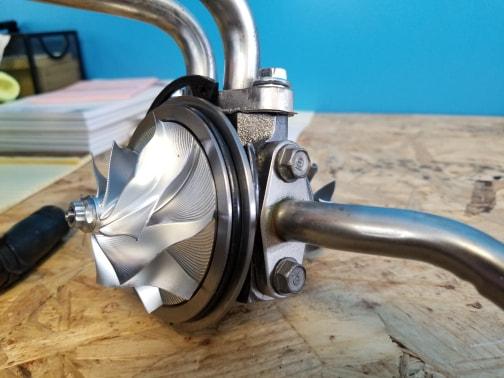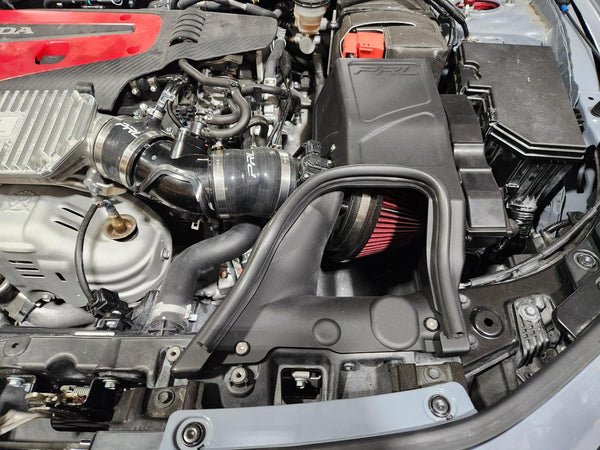As some of you may have seen, we have been testing our prototype drop-in turbocharger upgrade for the FK8 Civic Type-R platform over the past couple of weeks. What we haven’t shown, though, is the fact that we’ve spent countless hours over these weeks learning about the Bosch ECU, how these cars respond to turbocharger upgrades and testing the limits of factory and aftermarket components.
Prototype Turbocharger Specifications:
- Ball Bearing Center Section
- 8-Blade Billet Compressor with 50mm Inducer and 67mm Exducer
- 9-Blade Turbine Wheel with 52mm Inducer and 45.7mm Exducer


Prototype Compressor:

Factory Compressor:

Prototype Turbine:

Factory Turbine:

Prototype Center Section
Please ignore the cellphone quality pictures. Final product will be revised to look much cleaner if we decide to bring to market.
One of the first things we noticed upon testing was the fact that turbo spool was not lost; this upgrade spools identical to the factory turbocharger! Response and power remained similar throughout the power-band until ~5000 RPM. The upgraded turbo clearly outflowed the small factory unit from ~5000 RPM until redline at the same boost level(s).

For reference the Green Run 1 was with the factory turbocharger and Hondata’s “PRL Motorsports 93 Octane Map” basemap, which made 364 horsepower and 378 ft/lbs of torque, which spikes around ~24.5 PSI of boost and drops to ~21.5 PSI up top.
The Blue Run 8 was a similar map to Hondata’s basemap with our turbocharger upgrade, which put us at 395 horsepower and 382 ft/lbs of torque. We made numerous 385 - 410 horsepower runs here, but found the car to make rather inconsistent power for unknown (at the time) reasons. Our goal was to be able to see a 400+ horsepower pump gas number, but we could not get past limitations and inconsistencies. Immediately we began testing anything we could, between adjusting every possible table in Hondata, to swapping to KTuner, to checking for mechanical issues to even ruling out any of our products being some sort of restriction. It was at this point that we realized that we were at mercy of some sort of background table coding of the stock ECU that has not yet been touched. There’s a reason that most of the higher horsepower stock ECU cars flirt around the 400 horsepower barrier. Yes, the factory high pressure fuel pump is maxed out around 400 ft/lbs of torque, but there is enough injector duty cycle to compensate for this. Of course it would be beneficial to have more fueling here, but shifting the torque curve to the right and bypassing this torque spike will allow us to safely stretch the factory fuel system further with proper tuning and race gas. You can see that the top of the graph begins to look choppy when nearing 400 horsepower; this choppiness worsened when surpassing 400 horsepower on 93 octane due what we were thinking was engine knock. For this reason, we poured in MS100 fuel to rule this out, which allowed us to make the same/similar power without as much chop. However, we were still limited from overcoming this power barrier…
Run 4 is where we were finally able to test our theory for not being able to increase power/boost, and as you can see, the power went up! We accomplished 423 horsepower and 426 ft/lbs of torque spiking ~28.5 PSI of boost falling to ~23 PSI our very first run here. Though we were happy, our clutch was not. Luckily, the slipping clutch probably saved our stock engine from shooting a rod through the block.

We plan to strap our car back on the dyno in a few weeks once we install our clutch and a set of forged rods and pistons to really push this car to the next level. Given the fact that this turbo upgrade is still responding well to boost, we are confident that we can achieve 450 - 500 horsepower on this exact setup. In the meantime, we will be working with both Hondata and KTuner to supply them with any information needed to hopefully overcome these ECU limitations for the better sake of the community.




